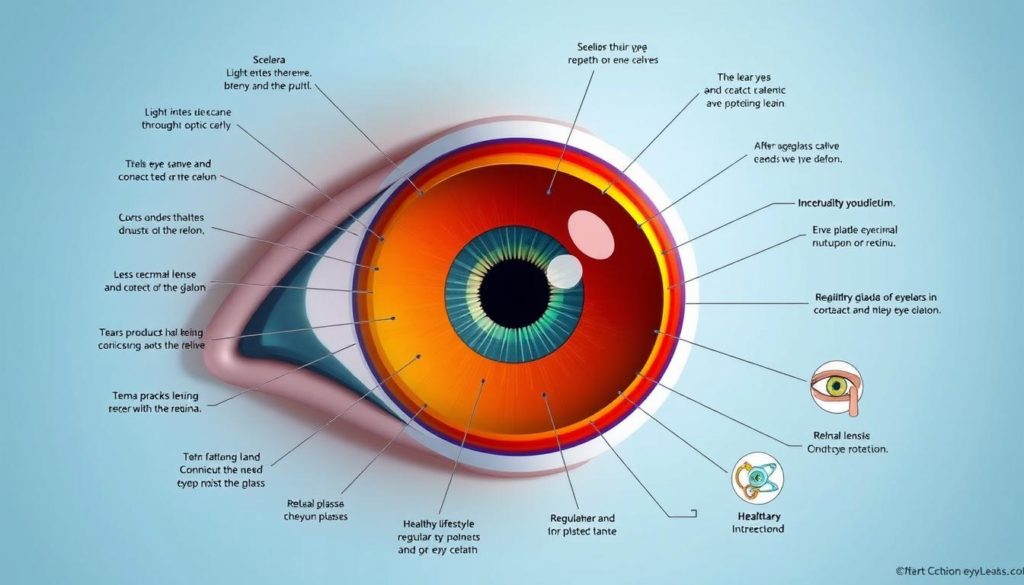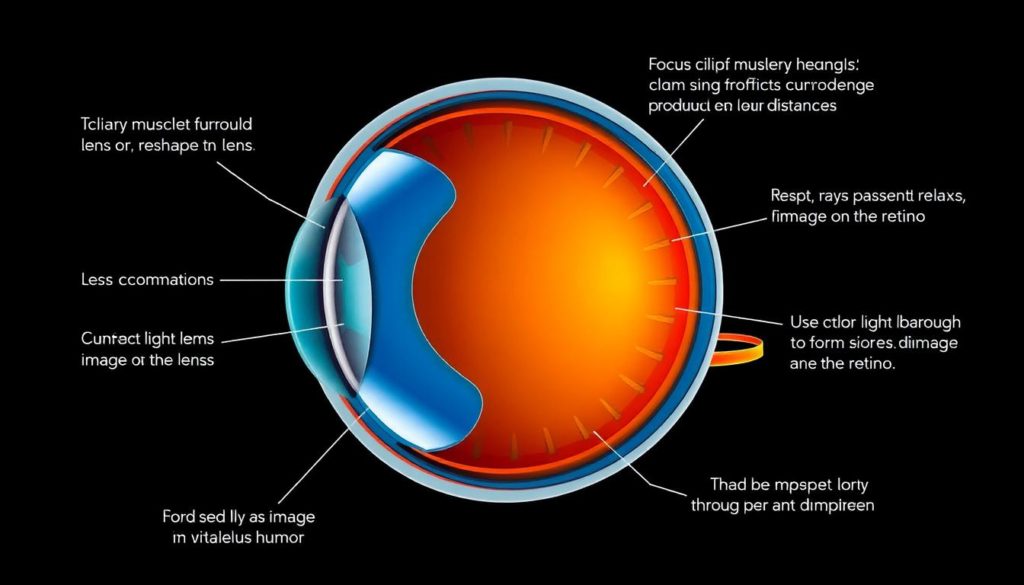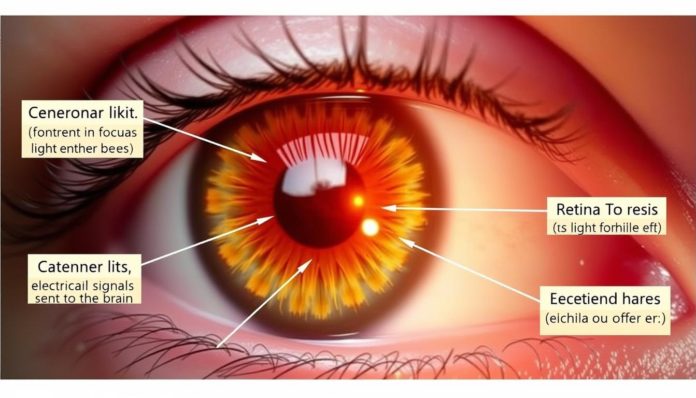Did you know over 80% of what we learn comes through our sense of sight? This fact shows how important our eyes are. Knowing how eyes work makes us value them more in our lives.
Our eyes work in a complex way to let us see the world. Light enters the eye through the cornea and changes into signals by the retina. Each part of the eye is key to this process.
The cornea bends the light while the pupil and iris control how much light gets in. The lens then adjusts the focus.
Furthermore, the retina changes light into signals for our brain. Even tears are essential, keeping our eyes moist and protected. Exploring eye mechanics helps us understand their amazing abilities and complexities.
Introduction to Eye Anatomy
The human eye is a complex organ made up of many parts. Each part is key for good vision and eye health. Knowing how the eye works lets us see the beauty of sight.

Main parts of the eye include the cornea, lens, iris, pupil, retina, and optic nerve. These are held in place by muscles and connective tissues. They also get support from blood vessels and nerves.
| Eye Component | Function | Importance |
|---|---|---|
| Cornea | Initial light bending | Protects and refracts light into the eye |
| Lens | Fine-tunes focus | Adjusts to focus light on the retina |
| Iris | Regulates light entry | Controls the size of the pupil |
| Retina | Captures images | Contains photoreceptors that detect light |
| Optic Nerve | Transmits visual information | Carries signals from the retina to the brain |
Every part of the eye is important for seeing and understanding what we see. Taking care of our eyes helps all these parts work right. This is key for keeping our vision clear for years to come.
The Path of Light Through the Eye
The journey of light through the eye is both complex and fascinating. It’s essential for us to see clearly. Each part of the eye plays a key role in making sure images are sharp and vivid. We’ll see how the cornea, pupil, and lens work together in this process.
Cornea: The Initial Light Bender
The cornea is the main player in bending light. It provides most of the eye’s optical power. With its transparent, dome-shaped surface, it directs light towards the lens. This is crucial for proper focusing.
The function of the cornea helps us see things in detail. It’s vital for clear vision.
Role of the Pupil and Iris
After light goes through the cornea, it hits the pupil. The iris, which is the colored part, controls the pupil’s size. So, it adjusts how much light gets in. This lets the eye cope with different lighting, ensuring we see well in all conditions.
Lens: Fine-Tuning Focus
Next, the light meets the lens. The lens sharpens the focus by changing its shape. This action, called lens accommodation, focuses light on the retina. It helps us see near and far objects clearly.

The cornea, pupil, and lens together guide light precisely through the eye. This teamwork is key to how we understand and perceive the world visually.
How the Retina and Photoreceptors Work
The retina is key in our eyes. It turns light into signals for the brain. This magic happens with photoreceptor cells in the retina. They are super important for keeping our vision sharp.
Function of Rods and Cones
Rods and cones are the stars in our retina. Rods let us see when it’s dark and spot moving things. Cones help us see colors and details, and they love bright light.
These cells are vital for our eyes to work well. If they get hurt, we might have big problems with our sight.
The Importance of the Macula
The macula is a tiny but mighty part of the retina. It helps us see clearly and catch details. This lets us read and recognize faces easily.
Its big job means if the macula has problems, our straight-ahead vision and life quality could suffer. That’s why it’s important to know how our retina and its cells work to keep our eyes healthy.
The Role of the Optic Nerve
The optic nerve is key to how our eyes work. It sends crucial visual info to the brain. Over a million nerve cells make this possible by carrying signals from the retina. This lets the brain make sense of what we see.
It’s important to know how the optic nerve functions. It links vision by sending light signals to the brain. Light gets turned into electrical signals by photoreceptors. Then, the optic nerve sends these signals to the brain. This process lets us see images. Without it, our vision would be greatly affected.
Let’s look at how the optic nerve works compared to other vision parts:
| Function | Description |
|---|---|
| Optic Nerve | Transmits visual information from retina to brain |
| Photoreceptors | Convert light into electrical signals |
| Retina | Processes the focused light from the lens |
| Brain | Interprets electrical signals into images |
In short, the optic nerve is vital for vision. It turns light into images we understand. This process is at the heart of how we see and know our world. The optic nerve ensures we can navigate and make sense of our surroundings.
Eye Function: From Light to Sight
Understanding eye function begins with the journey light takes from hitting the eye to when we see. Light first enters through the cornea, the eye’s front layer. The cornea bends the light as part of the visual process.
Then, the light goes through the pupil. The lens fine-tunes it, focusing the light onto the retina. This step is key for clear vision. The retina’s rods and cones change light into electrical signals. Rods are for seeing in dim light, and cones handle colors and detail.
These signals go to the brain through the optic nerve. There, they become the images we see. If the optic nerve doesn’t work right, it changes how we view the world.
To sum it up, seeing is a complex process. It turns light into the sight. Every part of the eye, from the cornea to the optic nerve, is essential in this process.
Common Eye Problems and Their Impact on Vision
Vision health is very important for our overall health. Different eye problems can make it hard to see well. We will look at common eye issues and their effect on our vision.
Refractive Errors
Refractive errors are very common and include myopia, hyperopia, astigmatism, and presbyopia. These happen when the eye’s shape stops light from focusing on the retina. This makes vision blurry. Glasses, contacts, or surgery can often correct these problems.
Corneal Disorders
The cornea is key in focusing light on the retina. Corneal diseases like keratitis and keratoconus can hurt our vision. Treatments can be medicine or surgery. It shows why catching these issues early is key for vision health.
Retinal Disorders
The retina turns light into messages for the brain. Problems like diabetic retinopathy and AMD can damage vision a lot. Getting your eyes checked often is crucial to find these early. This way, they won’t get too bad.
Optic Nerve-Related Conditions
The optic nerve sends visual info to the brain. Conditions like glaucoma can hurt the optic nerve and cause vision loss. Treatment can include medicine or surgery. This helps stop or lessen vision problems.
Age-Related Eye Disorders
Our vision can get worse as we get older because of conditions like cataracts and AMD. Cataracts make the lens cloudy, blurring vision. AMD affects the central vision we use for reading. Early treatment and changing how we live can help manage these conditions.
How to Maintain Vision Health
Keeping your eyes healthy is key to a great quality of life. It’s important to get regular eye exams and protect your eyes well. Here are tips to keep your vision in top shape.
Regular Eye Exams
Getting your eyes checked often is vital. These exams find early signs of conditions like glaucoma and cataracts. They include tests that check your vision and look for problems. Catching issues early helps make treatment more effective, helping you keep good vision.
- Adults aged 40 to 64 should have an eye exam every 2 to 4 years.
- Individuals over 65 are recommended to undergo exams every 1 to 2 years.
- Children need their eyes checked regularly as a part of general health check-ups.
Protective Measures for the Eyes
Using protective measures every day helps keep your eyes safe. Wear sunglasses that block all UV rays, and use safety goggles when needed. Also, take regular breaks when you’re looking at screens. This helps prevent eye strain and damage.
- Sunglasses: Shield your eyes from UV light with sunglasses that block all UV radiation.
- Safety Goggles: Wear protective eyewear for risky activities, like construction or sports.
- Screen Time: Use the 20-20-20 rule to avoid digital eye strain: every 20 minutes, look at something 20 feet away for at least 20 seconds.
Add these easy tips into your daily life to boost your vision health. They’re simple but can make a big difference in keeping your eyes healthy.
Signs and Symptoms of Eye Conditions
It’s very important to notice early signs of eye issues. This can keep your vision at its best. Changes to the eyes come in different forms, like irritation or serious issues. Paying attention to these signs means you can get the right help early.
Surface Issues
Eye surface problems might show as redness, dryness, or an itchy feeling. These symptoms could point to conditions like conjunctivitis or dry eye syndrome. If you’re feeling constant discomfort, it’s a good idea to see an eye expert. This helps avoid bigger problems that could affect how well you see.
Appearance and Alignment Issues
How your eyes look and line up tells a lot about your eye health. Seeing things like bulging eyes or eyelids that droop could be a warning. Catching these signs early helps find conditions like thyroid eye disease. This means you can start treatment sooner.
Functional Symptoms Affecting Sight
Vision issues can also show up as blurred or double vision. Problems like cataracts can cause these symptoms. If you suddenly have trouble seeing at night or see floaters, get checked out right away. Quick action is key to dealing with serious issues like retinal detachment.
FAQ
How does the cornea contribute to vision?
The cornea serves as the eye’s first light bender. It refracts light, helping to focus it inside the eye.
What roles do the pupil and iris play in eye function?
The pupil controls light’s entry into the eye. Meanwhile, the iris changes the pupil’s size based on light levels.
How does the lens fine-tune focus?
The lens sharpens light’s focus. This ensures that it precisely hits the retina, making our vision clear.
What are the functions of rods and cones in the retina?
Rods are crucial for seeing in dim light and shapes. On the other hand, cones manage color vision and detail.
Why is the macula important?
The macula is key for central vision. It allows us to see fine details clearly.
How does the optic nerve impact vision?
The optic nerve sends visual signals from the retina to the brain. The brain then interprets these signals into images.
What conditions can affect vision?
Several issues can harm vision. These include refractive errors, problems with the cornea or retina, optic nerve complications, and aging eyes.
How can I maintain good vision health?
To keep your eyes healthy, get regular check-ups. Also, wear sunglasses and avoid overworking your eyes.
What are common signs and symptoms of eye conditions?
Look out for symptoms like eye irritation, changes in looks or eye position, and blurry vision.


